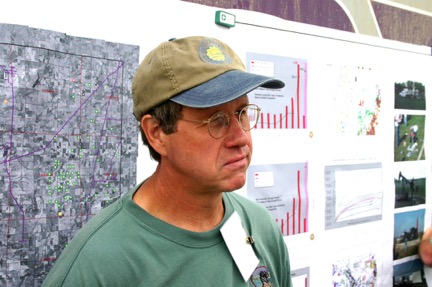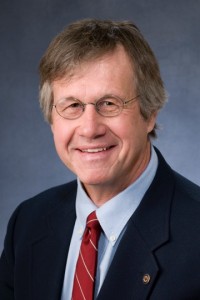16 March 2015
Q&A with journalist-turned-geologist Rex Buchanan (Part 1): From journalist to geologist
Posted by mcadams

Rex Buchanan, interim director of the Kansas Geological Survey, spent decades working as a science reporter. Photo courtesy of Kansas Geological Survey.
By Kerry Klein
After decades as a science reporter, interim director of the Kansas Geological Survey (KGS) Rex Buchanan now finds himself at the epicenter of a media frenzy. This is the first in a three-part series featuring an interview between Buchanan and University of California, Santa Cruz, science journalism student, Kerry Klein. Klein interviewed Buchanan after a symposium on induced seismicity at the 2015 annual meeting of the American Association for the Advancement of Science in San Jose, Calif.
When Rex Buchanan became interim director of the Kansas Geological Survey in 2010, earthquakes there were practically unheard of. Only a handful had occurred in the previous ten years, and none at all since 2008. But beginning in 2013, at least one tremor large enough for people to feel rattles Kansas every few days—an uptick in seismic activity that researchers have tied to the state’s oil and gas industry.
Reporters have been quick to jump on the link. Many mistakenly blame the quakes on hydraulic fracturing, or fracking, in which geologists crack open subsurface rock formations using high-pressure fluid to extract oil and gas buried underground.
A frequent source for media interviews, Buchanan finds himself setting the record straight, explaining that the more likely cause of the quakes is wastewater injection (also known as saltwater disposal), the process of forcing the saltwater produced during oil and gas extraction back into the ground. Although the pressure that fracking induces is released once oil or gas begins to flow, saltwater disposal adds pressure as more and more fluid is forced underground, and it’s this pressure that can trigger motion along faults.
Even without a geology degree, Buchanan might be better prepared than most for this public relations maelstrom. A science writer by training, with additional experience as a University of Kansas lecturer and a past president of the Kansas Academy of Sciences, Buchanan knows a thing or two about communicating with a lay audience. But that’s not to say his new job has been easy.
In February, Buchanan chaired a symposium on induced seismicity at the annual meeting of the American Association for the Advancement of Science in San Jose, Calif. He caught up with freelancer Kerry Klein to speak about how his media experience has influenced his role at the survey—and vice versa.
Part 1: From journalist to geologist
Why did you decide to become a journalist?
I put myself through college working as a sports writer for a newspaper. I think writing is kind of fun; it’s always gratifying. If you were to ask me what were the most satisfying things I’ve done professionally, it’s probably a book publication.
What were your books about?
Two of them were on geology in Kansas, and then I did a Grand Canyon book with another guy.
You don’t actually have a geology degree. How did you come to be the director of a state geological survey?
I’ve taken courses, and I spent a lot of time in the field. By doing those books, I felt pretty comfortable around geology. I’d also say that the job I have is an administrative one. That technical expertise is important but the ability to manage people is probably more important. When I go over to legislature, I’ll talk in general terms about what’s going on, but I always take along somebody who knows a lot more than I do.
How has your experience as a journalist influenced what you do now?
I think that background is really helpful in dealing with audiences like the legislature. And a lot of regulatory agencies have a culture of not talking to the press or to people. I’ve really tried to press our regulatory community to go out and talk to groups in the affected areas monthly, even when we don’t have any good reason to go—just go down and develop a relationship with them so that they trust us.
What would you say is the best part of your job?
In early January every year, we go out and measure water levels in the Ogallala aquifer. It’s cold and nasty, but we spend a week, GPS guiding us to about 1,400 water wells. I just think it’s so, so much fun. I could do that for free.
One Saturday afternoon, the wind came up and it was about zero [degrees Fahrenheit]. It snowed and it got pretty ugly. Because of how the well was situated I had to be looking in the north wind and my nose started to run. But I had like 300 feet of tape in the bottom of this well; I’d got both hands occupied. The wind caught the snot, blew it up on my glasses, and it froze solid. I was setting there, pulling up this tape, I can’t see, and I’m thinking, “I don’t have to do this.” But most days are a lot more fun.
Check back next Monday for Part 2 of Klein’s interview: “Walking a political tightrope.”
– Guest blogger Kerry Klein is a geologist turned journalist currently studying in the Science Communication Program at the University of California, Santa Cruz. She talks science and the media on Twitter. This post also appeared at the SciCom class blog, Out of the Fog–Emerging Science from California’s Central Coast.











 The Plainspoken Scientist is the science communication blog of AGU’s Sharing Science program. With this blog, we wish to showcase creative and effective science communication via multiple mediums and modes.
The Plainspoken Scientist is the science communication blog of AGU’s Sharing Science program. With this blog, we wish to showcase creative and effective science communication via multiple mediums and modes.
So you say that these unconventional methods of mining oil and gas are not the cause of your tremors? then what is?